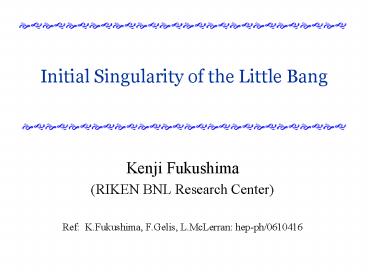Initial Singularity of the Little Bang PowerPoint PPT Presentation
1 / 18
Title: Initial Singularity of the Little Bang
1
Initial Singularity of the Little Bang
- Kenji Fukushima
- (RIKEN BNL Research Center)
- Ref K.Fukushima, F.Gelis, L.McLerran
hep-ph/0610416
2
Big Bang
Fluctuations Inflation (Instability) Reheating (
Thermalization)
3
Little Bang
- Space-Time Evolution of the Little Bang
Instability ? thermalization
Quantum Fluctuations after collision
Quantum Fluctuations before collision
Fluctuations (seeds) ? Instability ?
Thermalization
Fluctuations (seeds) ? Instability ?
Thermalization
4
Fluctuations and Instability
- Time Evolution of Fluctuations under Instability
Stable
c.f. Ordering process in continuous transition
Potential
Wavefunction
Instability
Classical evolution is a goodapproximation
unless the instabilityis weak (i.e. potential is
flat).
Singularity depending on the problem
5
Formula (after singularity)
- Quantum Mechanics
Similar results by S.Jeon (05)
tF is some time after singularity
WKB (semi-classical) approximation
xFc is a solution of the classical equationsof
motion at time tF
Wigner function characterizes the spectrum of
quantum fluctuations
Typically
6
Derivation (1/3)
Expansion around the classical path
assuming strong instability (WKB approximation)
7
Derivation (2/3)
c.f. Schwinger-Keldysh formalism
Only the surface terms remain due to the
equations of motion.
without approximation
8
Derivation (3/3)
Definitions
Variable Changes
(neglecting the associated Jacobian)
? Formula is derived
9
Solvable Example
- Inverted Harmonic Oscillator
Initial Wavefunction
with
Wigner Function
Classical Path
10
Application to the Little Bang
Formula
Initial background fields
Classical Equations of Motion
Right-moving Nucleus
Left-moving Nucleus
These equations have been solved numerically by
Romatschke-Venugopalan.
Instability w.r.t. h-dependent fields ? Weibel
Instability??
11
Weibel Instability
electron motion under Bz
resulting current density
e
Bz
electron
Bz
e
Fluctuations in Bz
Bz
Bz
Initial Bz is amplified by current density.
Seed of Instability
specified by Wavefunction or Wigner function
Instability
12
Fluctuations before Collision
Zero-Point Oscillation of Empty Steady State from
Infinite Past
Time-independent Schroedinger Equation
Ground-state Wavefunction at t0- (where Ah0)
Gauss Law
Cut-Off ?
13
How to pass over the singularity?
Kovner-McLerran-Weigert (95)
- Classical Part
Empty
source singularity
from
or the Gauss law
14
Boundary Conditions
Light-Cone Singularity
Source Singularity
Ex.
15
How to pass over the singularity?
- Fluctuation Part
Integration over the Schroedinger Equation from
t0- to z0
Hsing is the singular part of Hamiltonian
containing d(t)
Boundary Condition
Initial singularity shifts the fields by the
classical background
16
Fluctuation Spectrum
Wigner Function characterizing initial
fluctuations
Metric t2
Gauss law
17
Procedure
- Generate the initial conditions with fluctuations
Aa, Ee satisfying - Solve the classical equations of motion with this
initial condition. - Take the average over the distribution
offluctuations a and e.
18
Obstacle?
Large fluctuations for almost homogeneous
components.They should be suppressed by
non-linearity.
Large fluctuations for furiously
inhomogeneouscomponents.
What results from our initial conditions for the
Glasma instability?

